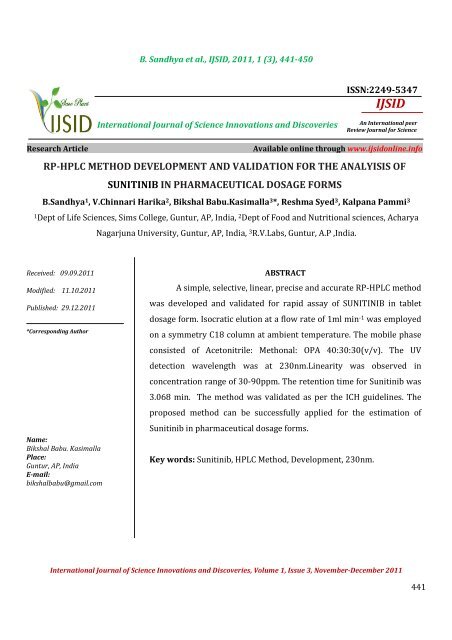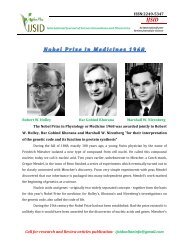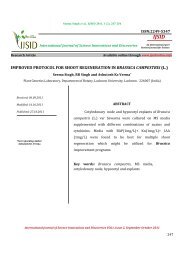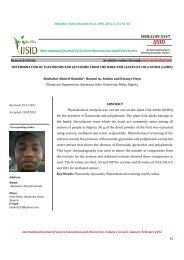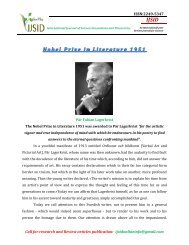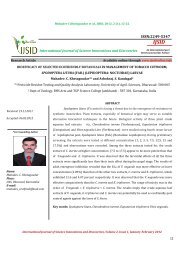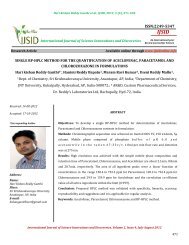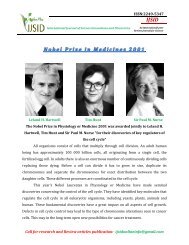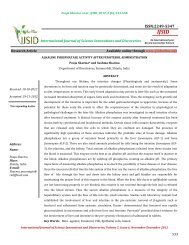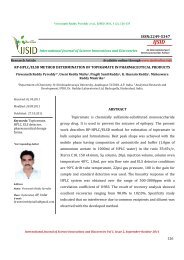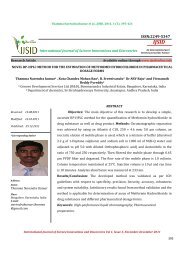rp-hplc method development and validation for the ... - Ijsidonline.info
rp-hplc method development and validation for the ... - Ijsidonline.info
rp-hplc method development and validation for the ... - Ijsidonline.info
You also want an ePaper? Increase the reach of your titles
YUMPU automatically turns print PDFs into web optimized ePapers that Google loves.
B. S<strong>and</strong>hya et al., IJSID, 2011, 1 (3), 441-450ISSN:2249-5347IJSIDInternational Journal of Science Innovations <strong>and</strong> DiscoveriesAn International peerReview Journal <strong>for</strong> ScienceResearch ArticleAvailable online through www.ijsidonline.<strong>info</strong>RP-HPLC METHOD DEVELOPMENT AND VALIDATION FOR THE ANALYISIS OFSUNITINIB IN PHARMACEUTICAL DOSAGE FORMSB.S<strong>and</strong>hya 1 , V.Chinnari Harika 2 , Bikshal Babu.Kasimalla 3 *, Reshma Syed 3 , Kalpana Pammi 31Dept of Life Sciences, Sims College, Guntur, AP, India, 2 Dept of Food <strong>and</strong> Nutritional sciences, AcharyaNagarjuna University, Guntur, AP, India, 3 R.V.Labs, Guntur, A.P ,India.Received: 09.09.2011Modified: 11.10.2011Published: 29.12.2011*Corresponding AuthorName:Bikshal Babu. KasimallaPlace:Guntur, AP, IndiaE-mail:bikshalbabu@gmail.comABSTRACTA simple, selective, linear, precise <strong>and</strong> accurate RP-HPLC <strong>method</strong>was developed <strong>and</strong> validated <strong>for</strong> rapid assay of SUNITINIB in tabletdosage <strong>for</strong>m. Isocratic elution at a flow rate of 1ml min -1 was employedon a symmetry C18 column at ambient temperature. The mobile phaseconsisted of Acetonitrile: Methonal: OPA 40:30:30(v/v). The UVdetection wavelength was at 230nm.Linearity was observed inconcentration range of 30-90ppm. The retention time <strong>for</strong> Sunitinib was3.068 min. The <strong>method</strong> was validated as per <strong>the</strong> ICH guidelines. Theproposed <strong>method</strong> can be successfully applied <strong>for</strong> <strong>the</strong> estimation ofSunitinib in pharmaceutical dosage <strong>for</strong>ms.INTRODUCTIONKey words: Sunitinib, HPLC Method, Development, 230nm.INTRODUCTIONInternational Journal of Science Innovations <strong>and</strong> Discoveries, Volume 1, Issue 3, November-December 2011441
B. S<strong>and</strong>hya et al., IJSID, 2011, 1 (3), 441-450INTRODUCTIONSunitinib (marketed as Sutent by Pfizer, <strong>and</strong> previously known as SU11248) is an oral, smallmolecule,multi-targeted receptor tyrosine kinase (RTK) inhibitor that was approved by <strong>the</strong> FDA <strong>for</strong> <strong>the</strong>treatment of renal cell carcinoma (RCC) <strong>and</strong> imatinib-resistant gastrointestinal stromal tumor (GIST) onJanuary 26, 2006. Sunitinib was <strong>the</strong> first cancer drug simultaneously approved <strong>for</strong> two differentindications. [1]IUPAC NameN-(2-diethylaminoethyl)-5-[(Z)-(5-fluoro-2-oxo-1H-indol-3-ylidene)methyl]-2,4-dimethyl-1Hpyrrole-3-carboxamideSunitinib inhibits cellular signaling by targeting multiple receptor tyrosinekinases (RTKs).These include all receptors <strong>for</strong> platelet-derived growth factor (PDGF-Rs) <strong>and</strong> vascularendo<strong>the</strong>lial growth factor receptors (VEGFRs), which play a role in both tumor angiogenesis <strong>and</strong> tumorcell proliferation. The simultaneous inhibition of <strong>the</strong>se targets <strong>the</strong>re<strong>for</strong>e leads to both reduced tumorvascularization <strong>and</strong> cancer cell death, <strong>and</strong> ultimately tumor shrinkage.Sunitinib also inhibits KIT(CD117), [2] <strong>the</strong> RTK that (when improperly activated by mutation) drives <strong>the</strong> majority of gastrointestinalstromal cell tumors. [3] It has been recommended as a second-line <strong>the</strong>rapy <strong>for</strong> patients whose tumorsdevelop mutations in KIT that make <strong>the</strong>m resistant to imatinib, or who become intolerant to <strong>the</strong>drug. [4][5] In addition, sunitinib inhibits o<strong>the</strong>r RTKs. [6] These include: like RCC, GIST does not generallyrespond to st<strong>and</strong>ard chemo<strong>the</strong>rapy or radiation. Imatinib was <strong>the</strong> first cancer agent proven effective <strong>for</strong>metastatic GIST <strong>and</strong> represented a major <strong>development</strong> in <strong>the</strong> treatment of this rare but challengingdisease. However, approximately 20% of patients do not respond to imatinib (early or primaryresistance), <strong>and</strong> among those who do respond initially, 50% develop secondary imatinib resistance <strong>and</strong>disease progression within 2 years. Prior to sunitinib, patients had no <strong>the</strong>rapeutic option once <strong>the</strong>ybecame resistant to imatinib. [7]International Journal of Science Innovations <strong>and</strong> Discoveries, Volume 1, Issue 3, November-December 2011442
B. S<strong>and</strong>hya et al., IJSID, 2011, 1 (3), 441-450Sunitinib offers patients with imatinib-resistant GIST a new treatment option to stop fur<strong>the</strong>r diseaseprogression <strong>and</strong>, in some cases, even reverse it. This was shown in a large, Phase III clinical trial in whichpatients who failed imatinib <strong>the</strong>rapy (due to primary resistance, secondary resistance, or intolerance)were treated in a r<strong>and</strong>omized <strong>and</strong> blinded fashion with ei<strong>the</strong>r sunitinib or placebo. [7] The study wasunblinded early, at <strong>the</strong> very first interim analysis, due to <strong>the</strong> clearly emerging benefit of sunitinib. At thattime, patients receiving placebo were offered to switch over to sunitinib. In <strong>the</strong> primary endpoint of thisstudy, median time to tumor progression (TTP) was more than 4-fold longer with sunitinib (27 weeks)compared with placebo (6 weeks, P
PrecisionB. S<strong>and</strong>hya et al., IJSID, 2011, 1 (3), 441-450Table.3 Linear Regression Data <strong>for</strong> Calibration curveDrug SUNITINIBConcentration range 70-10ppmSlope (m) 0.002422Intercept (b) 0.103467Correlation coefficient 0.999% RSD Intra day-0.63Interday-0.64Repeatability of <strong>the</strong> <strong>method</strong> was checked by injecting replicate injections of 30 ppm of <strong>the</strong> solution<strong>for</strong> six times on <strong>the</strong> same day as intraday precision study of SUNITINIB <strong>and</strong> <strong>the</strong> RSD was found to be 0.63<strong>for</strong> intraday <strong>and</strong> 0.64<strong>for</strong> interday.AccuracyTable 4: Precision parameters of SUNITINIBINJECTION CONCENTRATION INTRA DAY INTER DAY1 30ppm 12361 124162 30ppm 12413 125123 30ppm 12295 123094 30ppm 12391 124255 30ppm 12420 125096 30ppm 12218 12361RSD 0.63 0.64The accuracy of <strong>the</strong> <strong>method</strong> was determined by calculating recovery of SUNITINIB by <strong>the</strong> <strong>method</strong>of st<strong>and</strong>ard addition. Known amount of SUNITINIB (10ppm, 20ppm <strong>and</strong> 30ppm) was added to a prequantified sample solution <strong>and</strong> <strong>the</strong> amount of SUNITINIB was estimated by measuring <strong>the</strong> peak arearatios <strong>and</strong> by fitting <strong>the</strong>se values to <strong>the</strong> straight line equation of calibration curve. The recovery studieswere carried out three times over <strong>the</strong> specified concentration range <strong>and</strong> amount of SUNITINIB wasestimated by measuring <strong>the</strong> peak area ratios by fitting <strong>the</strong>se values to <strong>the</strong> straight line equation ofcalibration curve. From <strong>the</strong> above determination, percentage recovery was calculated <strong>and</strong> <strong>the</strong> averagerecovery was found to be 99.23%SpecificityThe specificity of <strong>the</strong> <strong>method</strong> was determined by comparing test results obtained from analysis ofsample solution containing excipients with that of test results those obtained from st<strong>and</strong>ard drug.International Journal of Science Innovations <strong>and</strong> Discoveries, Volume 1, Issue 3, November-December 2011447
B. S<strong>and</strong>hya et al., IJSID, 2011, 1 (3), 441-450LOD <strong>and</strong> LOQFigure 3: Typical chromatogram of SUNITINIBLimit of detection (LOD) <strong>and</strong> limit of quantification (LOQ) were calculated as 0.1ppm <strong>and</strong> 0.4ppmrespectively as per ICH guide-lines. Results are shown in table 5.RobustnessTable 5: Results of LOD <strong>and</strong> LOQ.ParameterMeasuredLOD0.1ppmLOQ0.3ppmTo determine <strong>the</strong> robustness of <strong>the</strong> <strong>method</strong>, two parameters from <strong>the</strong> optimized chromatographicconditions were varied. Results of Robustness are shown in table 6.Table 6: Robustness resultsParameter Modification Peak Area % of changeSt<strong>and</strong>ard No change 21253 ……….M.PHASE Acetonitrile:Methanol:OPA 30:40:70 12457 0.777PH 5.2 12598 1.66WAVELENGTH 237nm 12490 1.044System Suitability Parameter:System suitability tests were carried out on freshly prepared st<strong>and</strong>ard stock solutions ofSUNITINIB <strong>and</strong> it was calculated by determining <strong>the</strong> st<strong>and</strong>ard deviation of SUNITINIB st<strong>and</strong>ards byinjecting st<strong>and</strong>ards in six replicates at 6 minutes interval <strong>and</strong> <strong>the</strong> values were recorded inTable7.International Journal of Science Innovations <strong>and</strong> Discoveries, Volume 1, Issue 3, November-December 2011448
B. S<strong>and</strong>hya et al., IJSID, 2011, 1 (3), 441-450Table7: System suitability parameters of SUNITINIBParametersValuesλ max (nm)230nmBeer’s law limit (μg/ml) 10-705ppmCorrelation coefficient 0.999Retention time 3.068 minTheoretical plates 8284Tailing factor 1.68Limit of detection 0.1ppmLimit of quantification 0.4ppmOptimization of <strong>the</strong> chromatographic conditionsRESULT AND DISCUSSIONThe nature of <strong>the</strong> sample, its molecular weight <strong>and</strong> solubility decides <strong>the</strong> proper selection of <strong>the</strong>stationary phase. The drug SUNITINIB being non-polar is preferably analyzed by reverse phase columns<strong>and</strong> accordingly C18 column was selected. So <strong>the</strong> elution of <strong>the</strong> compound from <strong>the</strong> column wasinfluenced by polar mobile phase. The concentration of <strong>the</strong> methanol <strong>and</strong> Acetonitrile were optimized togive symmetric peak with short run time based on asymmetric factor <strong>and</strong> peak area obtained. Differentmobile phases were tried but satisfactory separation, well resolved <strong>and</strong> good symmetrical peaks wereobtained with <strong>the</strong> mobile phase Acetonitrile, Methanol,OPA 40:30:30 (V/V). The retention time ofSUNITINIB was found to be 3.068 min, which indicates a good base line. The RSD values <strong>for</strong> accuracy <strong>and</strong>precision studies obtained were less than 2% which revealed that developed <strong>method</strong> was accurate <strong>and</strong>precise. The system suitability <strong>and</strong> <strong>validation</strong> parameters are given in Table 7. The high percentage ofrecovery of SUNITINIB was found to be 99.23 indicating that <strong>the</strong> proposed <strong>method</strong> is highly accurate.Proposed liquid chromatographic <strong>method</strong> was applied <strong>for</strong> <strong>the</strong> determination of SUNITINIB in tablet<strong>for</strong>mulation. The result <strong>for</strong> SUNITINIB was comparable with a corresponding labelled amount . Theabsence of additional peaks indicates no interference of <strong>the</strong> excipients used in <strong>the</strong> tablets.Table 8: Formulation results of SUNITINIBFormulation Dosage Sample concentration %EstimationSutent (capsule) 50mg 30ppm 99.74CONCLUSIONA validated RP-HPLC <strong>method</strong> has been developed <strong>for</strong> <strong>the</strong> determination of SUNITINIB in tabletdosage <strong>for</strong>m. The proposed <strong>method</strong> is simple, rapid, accurate, precise <strong>and</strong> specific. Its chromatographicrun time of 3.068 min allows <strong>the</strong> analysis of a large number of samples in short period of time. There<strong>for</strong>e,it is suitable <strong>for</strong> <strong>the</strong> routine analysis of SUNITINIB in pharmaceutical dosage <strong>for</strong>m.International Journal of Science Innovations <strong>and</strong> Discoveries, Volume 1, Issue 3, November-December 2011449
B. S<strong>and</strong>hya et al., IJSID, 2011, 1 (3), 441-450REFERENCES1. US Food <strong>and</strong> Drug Administration (2006). "FDA approves new treatment <strong>for</strong> gastrointestinal <strong>and</strong>kidney cancer".2. Hartmann JT, Kanz L (November 2008). "Sunitinib <strong>and</strong> periodic hair depigmentation due totemporary c-KIT inhibition". Arch Dermatol 144 (11): 1525–6.doi:10.1001/archderm.144.11.1525.3. "Prescribing in<strong>for</strong>mation <strong>for</strong> Sutent (sunitinib malate)". Pfizer, Inc, New York NY.4. Demetri GD et al. (2006). "Efficacy <strong>and</strong> safety of sunitinib in patients with advanced gastrointestinalstromal tumour after failure of imatinib: a r<strong>and</strong>omised controlled trial". Lancet 368 (9544): 1329–1338.5. "Phase II Trial of Sunitinib (SU011248) in Patients With Recurrent or Inoperable Meningioma"6. "Pfizer Scores New Approval <strong>for</strong> Sutent in Europe". 2 Dec 2010.7. FDA approves Sutent <strong>for</strong> rare type of pancreatic cancerInternational Journal of Science Innovations <strong>and</strong> Discoveries, Volume 1, Issue 3, November-December 2011450


